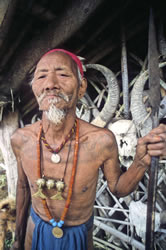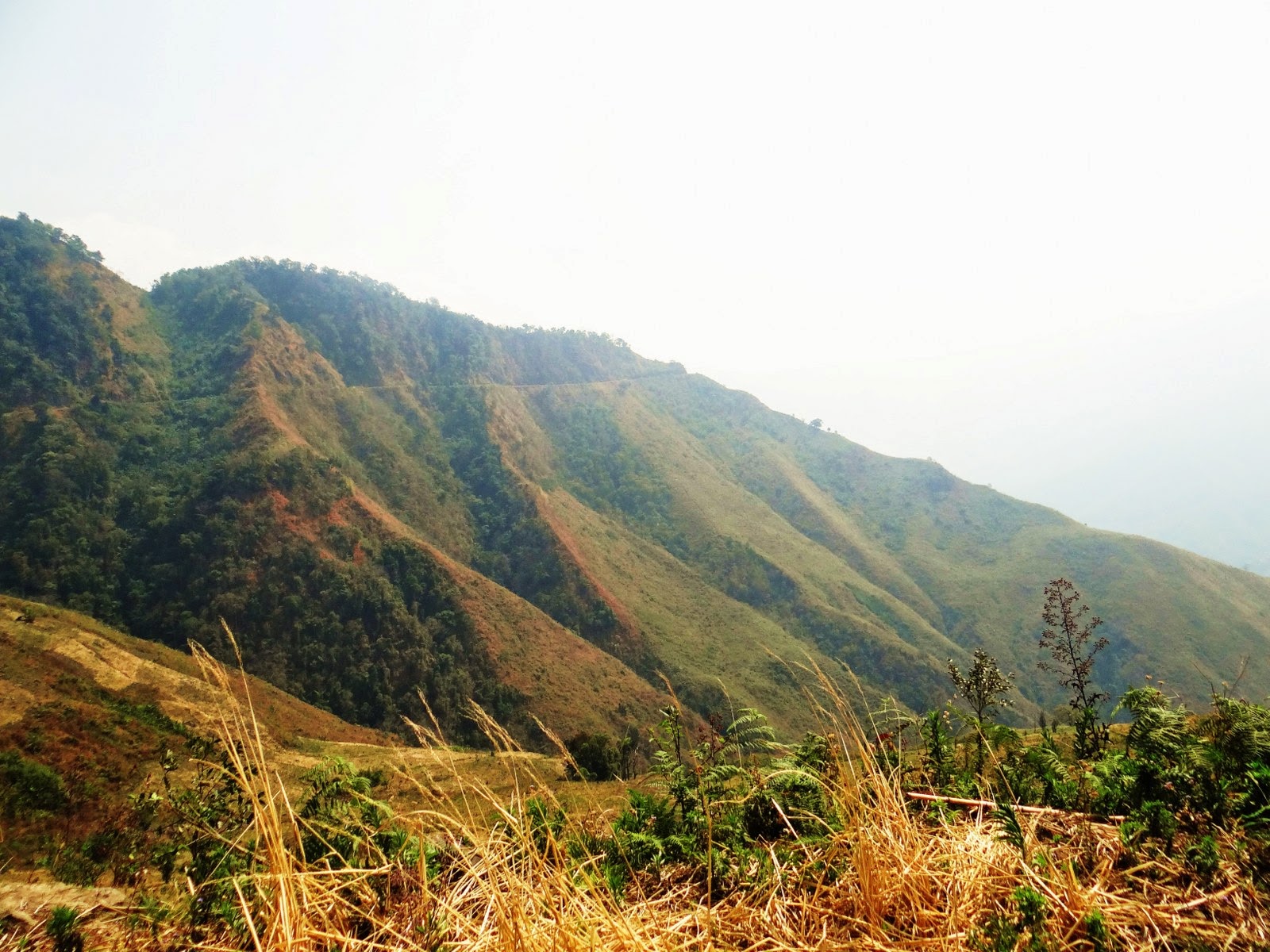-By Dr. Manlong Ralongham, MA, PhD
In every tribal society there are legends to describe the
origin of human being. These legends also tell about the various activities of
man, such as how man learnt cultivation, constructions of house, how he got
war, the art of singing and dancing, where from the seeds came, etc. The
Wanchos also have similar legends about their origin as well as the origin of
human being. As in olden days, the Wanchos were known as Rang pang. Mother in
the pains of Assam used to sub-due naughty children by telling them if they
didn’t behave properly and cry then Rang pang would come and take them away.
They have referred to Wanchos who lived in forfeited village along the Patkai
range, who would descend on the plains and forced men, women and children to
slavery and even for sacrifice. The Ahom, who entered the valley of Brahmaputra
along the Buri Dihing valley crossing Patkai range in the vicinity of present
Vijaya Nagar in 1226, perhaps preceded the Wanchos. Like other tribes of
Arunachal, the Wanchos have their own traditional, mythology or legends about
origin and migration. Among these mythologies, the Wancho theory is accepted as
the meaning of Wancho. Therefore, the meaning of Wancho is hill men who are
followers of Wangham.
MYTHOLOGY OF ORIGIN AND MIGRATION
There are many mythologies or legends regarding the
origin and migration of Wancho. According to myths of Wanchos, the lore relates
how and when Wancho tribe originated. It is said that since time immemorial the
king of water was named “Namwand” (crocodile). Once it came out from the water
in the form of buffalo and was wandering in the jungle. A group of hunters
killed that buffalo and everybody took the meat at meal. Only a woman named
Khangtheak and her beautiful daughter Toizam didn’t prefer to take. Other Namwangs
were provoked by this news. They let water to flow out of river and thus the
whole earth got submerged in flood, excepting the woman and her daughter who
did not participate in the feast. The lore continues that Toizam was conceived
by the wind and after nine months she gave birth to a child and was named as
Ophannu also called as Nyannu Uphannu. And thereafter this generation was
called Ophannu. Therefore, Uphannu is regarded as ancestor of the whole Wanchos.
Verrier Elwin (1960) narrates the mythology of Wanchos; two
brothers jointly migrated from a place called Ophannu, perhaps in North China
to Patkai Mountain range. The reason behind their migration perhaps may be due
to natural calamities like flood etc. that compelled them to migrate to safer
place. The elder one decided to settle in the area of Burma and younger one
came towards the present area of Tirap district. He came across many tribes
like Nocte and Assamese in the hill tract of north and northeast and the plain
area below. According Wancho Myths, Assamese and Wanchos are said to be
descendents of one ancestor. There were no differences among the people in
respect of ethnicity and classes in the society. Hence, Nocte, Wanchos are from
one common ancestor although in due course of time they started having separate
settlements. And they also started speaking slightly different dialects. There,
thus, developed some differences. Otherwise culturally and traditionally they
were almost same. Natural calamities like flood and earthquake occurs frequently
in those days. Due to which few people from plain too came up. Another
legend narrates that when a great flood occurred, all the living creatures were
drowned except a man named Aju and a women Ajong. Flood could not reach them as
they took shelter on top of hill. Therefore, the Wanchos believe that all the
Wanchos are descendants of Aju and Ajong.
Another legend
narrates that when a great flood occurred, all the living creatures were
drowned except a man named Aju and a women Ajong. Flood could not reach them as
they took shelter on top of hill. Therefore, the Wanchos believe that all the
Wanchos are descendants of Aju and Ajong.
There is also a lore
reported to be same in Chinese chronicle about a women who was conceived by the
wind. However, there is no written record or any account to say when the
Wanchos first lived in their present habitat or whether they are the indigenous
people of the area or when they have first migrated. From the information
available in different Buranjis, it may however, be said that, when the Ahom
King Sukafa first came and established his kingdom in Assam sometimes in the
first half of the 13th century A.D (1228) the Wanchos were there in occupation
of the area. From this it may be presumed that the Wanchos migrated many
hundred years ago. The exact period of migration is however difficult to
conjecture. About the history of migration also we have no other alternative
then to depends upon the various legends current among the people. These
legends are handed down traditionally by words and no written document is
available.
Through the above source of myths and
legends, we came to know about the migration of Wanchos up to some extent.
According to some legends the Wanchos came to their present habitat during the
time of Maiphan Mihjan, meaning during the period when human being started
scattering from one place to another. (Their memory does not go beyond maiphan
mihjan and ophannu). And Ophannu or Ophan-tinu is the original place of the
Wanchos (perhaps the Nyannu Opham is situated towards the southwest beyond the
Patkai hills). Then the Wanchos migrated via-Burma and part of Tuensang
district of Nagaland (the Tuensang area was under NEFA), from a place called
Longphoh Sangnu. In due course of time, the Wanchos were divided into two
sub-groups i.e. Tangjen and Sangjen, or Sang and Tang, named after two big
villages in Mon district of Nagaland. According to some mythology, Nyannu and
Ophan/Ofan are two different places while other thinks it to be one. From
Nyannu Opan they came to Tinao, a place near an unidentified river. From Tinao
they split in to two groups, each taking a different route, via Tangnu and
Sangnu, till both finally came to and settles in the present habitat. These two
groups came to be known as Tangjen and Sangjen respectively.
These two original
groups (Groups are called jen in Wancho) later broke up into smaller groups,
each one of which also has its own legend of migration. The Tangjen or
Tangkainusa migrated towards the southern part of Wanchos. The groups who had
migrated through Tang areas are called Tangjen and the group of people came
from Sang areas are called as Sangjen. Again these two groups are splitted into
many sub-groups like Tingpong Sejen and Ngoipa Sejen etc.
According to the
Wancho myth, it is said that the Tangjen took ember (fire) locally called Wann
from Tangnu and separated to present place. While Sangkaisa Nu or Sang migrated
from North Western and South Western parts of the present habitat of the
Wanchos. Thus the Sang or Tsangkainusa groups are called as Sangjen (lower
Wanchos). It is also said that the Tsangjen or Sang Wanchos had migrated from
Sangnu by taking the feather of bird and tooth of animal and have crossed the
land of Sang. Hence, the upper Wanchos and Lower Wanchos were decendants of one
ancestor.
MEANING OF WANCHO
After interaction
with the elderly people, it came to be known that there is consensus concept
among the people regarding the origin of name and meaning of the term Wancho
and there are three to four mythologies on it.
1. Wang-cho:
According to this, the word Wancho is derived from local term Wang-cho which
means the hill man of Wang follower or hill man living under the domain of
King. The word Wang stands for Wang (King) and the Cho means Hillman.
2. Wang- to: Few
others observed that the word Wancho means follower of Wangham(King).
3. Waan-to: A
section of people maintained that, the meaning of Wancho means
Waan-to(Law-follower) means to live under the law of village formulated by the
forefather
4. Rang Wango:
Others propounded that the common practice of rang wan-to could be a probable
origin of the word. The tribe celebrates annual festival with the worship of
rangwan i.e. use of long bamboo with its branches and leaves on a platform
during Oriah (annual) festival.
CLASSIFICATION OF WANCHOS GROUPS
The whole Wanchos tribe may be broadly classified into two
groups Tangjen and Sangjen on the basis of migration.
They are as follows:-
Tangjen groups (major villages): The Tangjens occupy
the area from Pongchau up to Nginu, Longkai and Wakka i.e.
1. Pongchau
2. Bohnyah
3. Khasa
4. Kamhua Noknu
5. Kamhua Noksa
6. Konnu
7. Kampong
8. Khanu
9. Konsa
10. Votnu
11. Chongkhaw
12. Chop
13. Kaimoi
14. Khuagla
15. Longkai
16. Nyinu
17. Nyisa
18. Wakka
Sangjen groups (major villages)
1. Nyaunu
2. Nyausa
3. Chatong
4. Chating
5. Longkhaw
6. Longphong
7. Mingtong
8. Pumao
9. Senua
10. Zedua
11. Longshom
12. Chanu
13. Ozakho
14. Chopnu
15. Chopsa
16. Rusa
17. Runu
18. Wanu
19. Nokfan
































